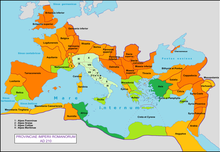Phoenice (Roman province)
| Provincia Syria Phoenice ἐπαρχία τῆς Φοινίκης Συρίας | |||||||||||||||
|---|---|---|---|---|---|---|---|---|---|---|---|---|---|---|---|
| Province of the Roman Empire (after 395 of the Byzantine Empire) | |||||||||||||||
| c. 194–630s | |||||||||||||||
 Roman Empire in 210 | |||||||||||||||
| Capital | Tyre | ||||||||||||||
| Historical era | Late Antiquity | ||||||||||||||
• Created by Septimius Severus | c. 194 | ||||||||||||||
| 630s | |||||||||||||||
| |||||||||||||||
| Today part of | |||||||||||||||
Phoenice (Latin: Syria Phoenīcē Latin: [ˈsʏ.ri.a pʰoe̯ˈniː.ke]; Template:Lang-grc-koi Greek pronunciation: [(h)e̝ pʰyˈni.ke̝ syˈri.a]) was a province of the Roman Empire, encompassing the historical region of Phoenicia. It was officially created in 194 AD and after c. 400. Phoenice Syria was divided into Phoenice proper or Phoenice Paralia, and Phoenice Libanensis, a division that persisted until the region was conquered by the Muslim Arabs in the 630s.
Administrative history

Phoenicia came under the rule of the Roman Republic in 64 BC, when Pompey created the province of Syria. With the exception of a brief period in 36–30 BC, when Mark Antony gave the region to Ptolemaic Egypt, Phoenicia remained part of the province of Syria thereafter.[1] Emperor Hadrian (reigned 117–138) is said to have considered a division of the overly large Syrian province in 123/124 AD, but it was not until shortly after c. 194 AD that Septimius Severus (r. 193–211) actually undertook this, dividing the province into Syria Coele in the north and Syria Phoenice in the south.[1] Tyre became the capital of the new province, but Elagabalus (r. 218–222) raised his native Emesa to co-capital, and the two cities rivaled each other as the head of the province until its division in the 4th century.[1]
Diocletian (r. 284–305) separated the district of Batanaea and gave it to Arabia, while sometime before 328, when it is mentioned in the Laterculus Veronensis, Constantine the Great (r. 306–337) created the new province of Augusta Libanensis out of the eastern half of the old province, encompassing the territory east of Mount Lebanon.[2]
Phoenice I & Phoenice Libanensis
Constantine's province was short-lived, but formed the basis of the re-division of Phoenice c. 400 into the Phoenice I or Phoenice Paralia (Greek: Φοινίκη Παραλία, "coastal Phoenice"), and Phoenice II or Phoenice Libanensis (Φοινίκη Λιβανησία), with Tyre and Emesa as their respective capitals.[2] In the Notitia Dignitatum, written shortly after the division, Phoenice I is governed by a consularis, while Libanensis is governed by a praeses, with both provinces under the Diocese of the East.[3] This division remained intact until the Muslim conquest of the Levant in the 630s.[4] Under the Caliphate, most of the two Phoenices came under the province of Damascus, with parts in the south and north going to the provinces of Jordan and Emesa respectively.[5]
Ecclesiastical administration
The ecclesiastical administration paralleled the political, but with some differences. The bishop of Tyre emerged as the pre-eminent prelate of Phoenice by the mid-3rd century. When the province was divided c. 400, Damascus, rather than Emesa, became the metropolis of Phoenice II. Both provinces belonged to the Patriarchate of Antioch, with Damascus initially outranking Tyre, whose position was also briefly challenged by the see of Berytus c. 450; after 480/1, however, the Metropolitan of Tyre established himself as the first in precedence (protothronos) of all the Metropolitans subject to Antioch.[4]
References
- ^ a b c Eißfeldt 1941, p. 368.
- ^ a b Eißfeldt 1941, pp. 368–369.
- ^ Notitia Dignitatum, in partibus Orientis, I
- ^ a b Eißfeldt 1941, p. 369.
- ^ Blankinship 1994, pp. 47–48, 240.
Sources
- Blankinship, Khalid Yahya (1994). The End of the Jihâd State: The Reign of Hishām ibn ʻAbd al-Malik and the Collapse of the Umayyads. Albany, New York: State University of New York Press. ISBN 978-0-7914-1827-7.
- Eißfeldt, Otto (1941). "Phoiniker (Phoinike)". Realencyclopädie der Classischen Altertumswissenschaft. Vol. Band XX, Halbband 39, Philon–Pignus. pp. 350–379.
{{cite encyclopedia}}: Invalid|ref=harv(help)
- 2nd-century establishments
- 7th-century disestablishments in Asia
- Ancient Lebanon
- Lebanon in the Roman era
- Holy Land during Byzantine rule
- Geography of Phoenicia
- Provinces of the Roman Empire
- Provinces of the Byzantine Empire
- Roman Syria
- Byzantine Syria
- States and territories established in the 190s
- States and territories disestablished in the 7th century

